Table of Contents
CBSE Previous Year Question Papers Class 10 Science SA2 Outside Delhi – 2011
Time allowed: 3 hours Maximum marks: 90
GENERAL INSTRUCTIONS:
- The Question Paper comprises of two Sections, A and B. You are to attempt both the Sections.
- All questions are compulsory.
- All questions ofSection-A and all questions ofSection-B are to be attempted separately.
- Question numbers 1 to 3 in Section-A are one mark questions. These are to be answered in one word or in one sentence.
- Question numbers 4 to 6 in Section-A are two marks questions. These are to be answered in about 30 words each.
- Question numbers 7 to 18 in Section-A are three marks questions. These are to be answered in
about 50 words each. - Question numbers 19 to 24 in Section-A are five marks questions. These are to be answered in about 70 words each.
- Question numbers 25 to 36 in Section-B are questions based on practical skills. Question nos. 25 to 33 are MCQs. Each question is a one mark question. You are to select one most appropriate response out of the four provided to you. Question nos. 34 to 36 are short answer questions carrying two marks each.
SET I
SECTION A
Question.1 Draw the structure for ethanoic acid molecule, CH3COOH.
Answer. Ethanoic acid (CH3COOH)

Question.2 Give an example of a phenomenon where Tyndall effect can be observed.
Answer. The scattering of light by particles of colloid or suspension in its path is called Tyndall effect. When sunlight passes through the canopy of a dense forest, the tiny water droplets in the mist scatter sunlight.
Question.3 What is meant by biological magnification?
Answer. Some harmful chemicals like pesticides, when absorbed by the plants through soil and water, get transferred frorh first trophic to the last trophic level of the food chain. As these chemicals are non-degradable, their concentration in the bodies of living organisms at each trophic level progressively increases. This increase in the concentration of harmful chemicals in the body of living organisms at the each trophic level of a food chain is called biological magnification.
Question.4 Explain with the help of a diagram, how we are able to observe the sunrise about two minutes before the Sun gets above the horizon.
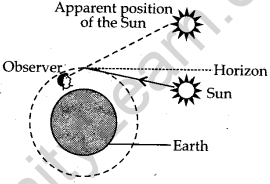
Answer. The Sun can be seen about two minutes before sunrise because when the Sun is slightly below the horizon, the Sun’s light coming from less dense air to more dense air is refracted downwards as it passes through the atmosphere. Thus due to this atmospheric refraction, the Sun appears to be raised above the horizon when actually it is slightly below the horizon.
Question.5 How does the valency of elements vary
- in going down a group, and
- in going from left to right in a period of the periodic table?
Answer.
- The valency of elements remains the same in going down a group.
- On moving from left to right in a period, the valency of elements increases from 1 to 4 and then decreases to 0 (zero).
Question.6 In the modern periodic table, the element Calcium (atomic number = 20) is surrounded by elements with atomic numbers 12, 19, 21 and 38. Which of these elements has physical and chemical properties resembling those of Calcium and why?
Answer.
Ca (atomic number = 20) (electronic configuration = 2, 8, 8, 2)
Element with
atomic number = 12 (electronic configuration = 2, 8, 2)
atomic number = 19 (electronic configuration = 2, 8, 8, 1)
atomic number = 21 (electronic configuration = 2, 8, 8, 3)
atomic number = 38 (electronic configuration = 2, 8, 18, 8, 2)
Elements with atomic number 12 and 38 have physical and chemical properties resembling with Ca because valence electrons in these elements are same as Ca, i.e., 2. As properties of an element depend on its valence electrons.
Question.7(a) List any two disadvantages of using fossil fuels for the production of energy.
(b) Give two examples each of the following:
- Renewable sources of energy;
- Non-renewable sources of energy
Answer.
(a) Disadvantages of using fossil fuels are:
- Fossil fuels are non-renewable source of energy.
- Elements like carbon, nitrogen and sulphur are present in fossil fuels. When fossil fuels are burnt, these elements react with oxygen of air to produce oxides which are acidic in nature. This leads to acid rain which adversely affects the quality of water and soil.
- CO2 is a gas which produces green house effect. This leads to global warming.
- CO produced is a toxic gas that causes respiratory problems.
(b)
- Examples of renewable sources of energy:
1. solar energy 2 tidal energy 3. hydel power (any two) - Examples of non-renezvable sources of energy:
1. diesel 2 petrol 3. CNG (any two)
Question.8 Describe any three ways in which individuals with a particular trait may increase in population.
Answer. The three ways in which individuals with a particular trait may increase in population:
- Geographical isolation of a population caused by various types of barriers such as mountain ranges, rivers and seas, etc. The geographical isolation leads to reproductive isolation and the individuals with a particular trait may increase in population.
- The struggle for survival within populations eliminates unfit individuals. Fit individuals (i.e., favourable trait) survive and reproduce. In other words, the variation if given survival advantage, it will be naturally selected.
- Genetic drift caused by drastic changes in the frequencies of particular genes by chance alone.
Question.9 State the evidence we have for the origin of life from inanimate matter.
Answer. An experiment conducted by Stanley L. Miller and Harold C. Urey in 1953 proved that origin of life takes place from inanimate matter. They assembled an apparatus to create an early earth like atmosphere which was supposed to consist of gases like methane, ammonia and hydrogen sulphide but no oxygen, over water.
This was maintained at a temperature just below 100°C and sparks were passed through the mixture of gases to simulate lightning. At the end of a week, 15% of the carbon (from methane) had been converted to simple compounds of carbon including amino acids which make up protein molecules.
Question.10’What are fossils? What do they tell us about the process of evolution?
Answer. The remains (or impressions) of dead animals or plants, that lived in the remote past, are known as fossils.
- Fossils provide evidence for evolution, e.g.r a fossil called Archaeopteryx had feathered wings like birds but teeth and tail like reptiles hence suggesting that birds and reptiles had a common ancestor.
- Fossils provide direct evidence of past life and thus provide convincing proof of organic evolution.
Question.11 (a) “The sex of the children is determined by what they inher.t from their father and not their mother.” Justify.
(b) Give an example where environmental factors like temperature determines the sex of the offspring.
Answer.(a)
- A male has one X chromosome and one Y chromosome.
- A female has two X chromosomes.
- If a sperm carrying X chromosome fertilises an ovum, then the child born will be a girl.
- If a sperm carrying Y chromosome fertilises an ovum, then the child born will be a boy.
Thus, the sperm determines the sex of the child.
(b) In some reptiles, the temperature at which the fertilised egg is incubated before hatching plays a role in determining the sex of the offspring.
Example: In a turtle, high incubation termperature leads to female offspring.
Question.12 Dams are useful for the society but there is public opposition to the construction of large dams. Justify your answer by giving three problems.
Answer.
- Social problems. Due to the construction of high rise dams, a large number of human settlements are submerged in the water of large reservoir formed by the dam.
- Environmental problems. The construction of high-rise dams leads to deforestation and loss of bio-diversity as vast variety of flora and fauna get submerged in the water of large reservoir formed by dam and disturb ecological balance.
- Economic problems. Construction of high-rise dams involves the spending of huge amount of public money without the generation of proportionate benefits.
Question.13 Write chemical equations for what happens when
(i) sodium metal is added to ethanoic acid.
(ii) solid sodium carbonate is added to ethanoic acid.
(iii) ethanoic acid reacts with a dilute solution of sodium hydroxide.
Answer.

Question.14 The atomic number of an element is 16. Predict
- the number of valence electrons in its atom;
- its valencies;
- its group number;
- whether it is a metal or a non-metal;
- the nature of oxide formed by it;
- the formula of its chloride.
Answer. The atomic number, Z = 16
![]()
- Number of valence electrons in its atom = 6
- Valency = 2
- Group number = 16
- It is a non-metal.
- The nature of oxide formed by it would be acidic.
- Let this element be represented by the symbol ‘X’. Formula of its chloride is XCl2.
Question.15 An object is placed between infinity and the pole of a convex mirror. Draw a ray diagram and also state the position, the relative size and the nature of the image formed.
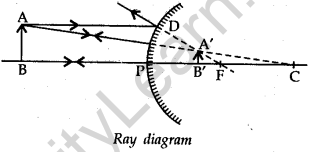
Answer. Position, size and nature of image:
Image formed by a convex mirror is virtual, diminished, erect and behind the mirror between its P (pole) and F (focus) point.
Question.16 What is the principle of reversibility of light? Show that the incident ray of light is parallel to the emergent ray of light when light falls obliquely on a side of-a rectangular glass slab.
Answer.
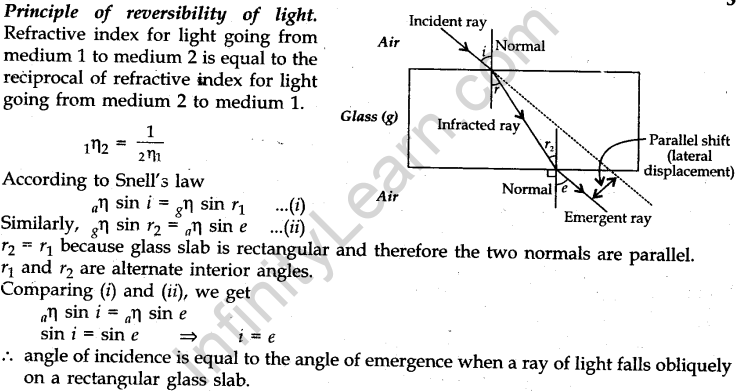
Question.17 What eye defect is myopia? Describe with a neat diagram how this defect of vision can be corrected by using a suitable lens.
Answer. Myopia is the defect of the eye vision due to which a person can see the near objects clearly, but he cannot see the far objects clearly.
Causes of myopia. Myopia is caused
— due to the elongation of the eye ball.
— due to decrease in the focal length of the eye lens. The eye lens becomes more convergent. Myopia can be corrected by using a concave lens of suitable focal length in the spectacles of such a person.

Question.18 What does HIV stand for? Is AIDS an infectious disease? List any four modes of spreading AIDS.
Answer. HIV. Human Immuno Deficiency Virus
This virus causes AIDS which is an infectious disease.
Modes of spreading AIDS:
- The AIDS disease usually spreads through unprotected sexual contact with an infected person carrying AIDS virus.
- The AIDS disease also spreads through the transfusion of blood contaminated with AIDS virus.
- The AIDS disease also spreads through the use of infected needles for injections.
- An AIDS infected mother can transmit the virus to her child during pregnancy or during birth.
Question.19 A team of Indian researchers went to Antarctica to study the ozone layer. They confirmed the presence of largest ozoye hole over Antarctica and was just short of 27 million sq. km. After few days of their return, one of the scientists developed rashes, burning sensation and other skin problems which the doctors have confirmed as skin cancer.
(a) What may be the cause of cancer just after return from Antarctica?
(b) What do we learn from this incident?
(c) Raghav, a student of your school organises a poster-making competition on the topic ‘Save Ozone’. What moral value is shown by Raghav? What other initiatives will you suggest in this regard?
Answer.
(a) The scientists were exposed to harmful UV-radiations of the sunlight as there was a big hole over Antarctica and this might be the cause of skin cancer. The ozone layer acts as an ozone shield and absorbs the harmful UV-radiations. The UV-radiations have extremely harmful effects on human beings, animals as well as plants.
(b) We learn that the ozone layer is very important for the existence and survival of life on earth.
Ozone layer absorbs high energy UV-radiations causing a rise in temperature of the stratosphere. The use of chemicals like CFCs has endangered the ozone layer. CFCs used as refrigerator coolants rise to the stratosphere where these molecules are broken down by UV- rays resulting in attack on the ozone molecules damaging the ozone umbrella of earth. Due to ozone layer depletion UV-rays reaching the earth cause skin cancer, cataracts, damage immune system, etc. UV-rays also decreases crop yield and certain fish larvae which are important constituents of aquatic food chains. It may also disturb global rainfall causing ecological disturbance. In this way all on the earth would be destroyed gradually.
(c) Raghav is showing concern for the environment. By this he is trying to make people aware of the harmful effects of the ozone hole on the earth’s environment. He ivants people to make efforts towards saving the ozone layer. Initiati’es as a student:
- by role play/arama/skits create awareness of the importance of ozone layer among the people;
- by writing slogans; and
- by organising debates and essay competitions.
Question.20 With the help of suitable diagrams, explain the various steps of budding in Hydra.
Answer. Hydra reproduces by budding which is an asexual type of reproduction.

During this type of reproduction, a bulb like projection arises from the parent body which is known as bud. The bud may be unicellular or multicellular formed by mitotic division of its cells. This bud then grows gradually to form a small hydra. And finally, the tiny new hydra detaches itself from the body of the parent hydra and lives as a separate organism. Thus, the parent hydra produces a new hydra.
Or
What is binary fission in organisms? With the help of suitable diagrams, describe the mode of reproduction in Amoeba.
Answer. Binary fission. Binary fission is an asexual method of reproduction in which the parent organism splits to form two new daughter organisms.
Reproduction in amoebit. Unicellular organisms like amoeba and paramoecium reproduce by binary fission. During this reproduction process, first the divides nucleus into two daughter nuclei followed by the division of cytoplasm.

Question.21 Explain isomerism. State any four characteristics of isomers. Draw the structures of possible isomers of butane, C4H10.
Answer. Isomerism. The existence of two or more different organic compounds having the same molecular formula but different structures is called isomerism.
Characteristics of isomerism:
- Isomers have the same molecular formula but different structures.
- In the phenomenon of isomerism, a given molecular formula can represent two or more different compounds.
- Isomers of a given molecular formula have entirely different properties.
- Isomerism is possible only with hydrocarbons having 4 or more carbon atoms.
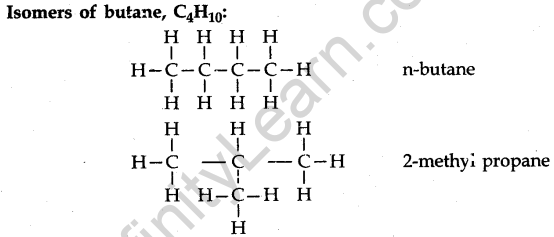
Question.22 (a)State two properties of carbon which lead to a very large number of carbon compounds.
(b)Why does micelle formation take place when soap is added to water? Why are micelles not formed when soap is added to ethanol?
Answer.
(a)The two properties of carbon which lead to a very large number of carbon compounds are: .
- Catenation. Catenation is the unique property of carbon atoms to form bonds with other atoms of carbon giving rise to large molecules.
- Tetravalency. Since carbon has a valency of four, it is capable of bonding with four other atoms of carbon or atoms of some other monovalent elements.
(b)Soap molecules consist of two parts —one hydrophilic (ionic ends) and other hydrophobic (hydrocarbon chains). Hydrophobic part of soap is dissolved with dirt and hydrophilic remains suspended in water. Thus more molecules of soaps are attached to dirt having their one end suspended in water to form a micelle.
Since ethanol is not as polar as soap, micelle will not be formed in other solvents such as ethanol.
Question.23 (a)What is meant by ‘power of a lens’?
(b)State and define the S.I. unit of power of a lens.
(c)A convex lens of focal length 25 cm and a concave lens of focal length 10 cm are placed in close contact with each other. Calculate the lens power of this combination.
Answer.
(a)The power of a lens is a measure of the degree of convergence or divergence of light rays falling on it.
(b)The SI unit of the power of a lens is dioptre. One dioptre is the power of a lens whose focal length is 1 metre.
(c)Focal length of the convex lens

Question.24(a) Draw a ray diagram to show the formation of image of an object placed between
infinity and the optical centre of a concave lens.
(b) A concave lens of focal length 15 cm forms an image 10 cm from the lens. Calculate
- the distance of the object from the lens
- the magnification for the image formed
- the nature of the image formed

Answer.
(a)When an object is placed any-where between infinity and optical centre of a concave lens, the image formed is
- between O and F.
- virtual.
- erect.
- diminished.
(b) Concave lens. Focal length, f = -15 cm
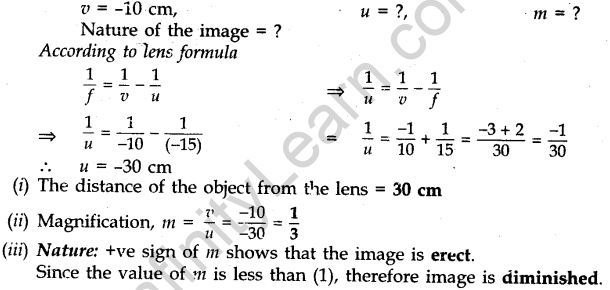
SECTION B
Question.25 Different paths of ray are shown in the following figures. Which of the following is
correct:

Answer. (c) Figure III only
Question.26 In these diagrams, the angle of refraction r is correctly marked in which diagram?

Answer.(d) IV
Question.27 To find the focal length of a concave mirror, sita should choose which one of the following set-ups?
(a) A mirror holder and a screen holder
(b) A screen holder and a scale
(c) A mirror holder, a screen holder and a scale
(d) A screen, a mirror, holders for them and a scale
Answer.(d) A screen, a mirror, holders for them and a scale
Question.28 Iron nails were dipped in an aqueous solution of copper sulphate. After about 30 minutes, it was observed that the colour of the solution changed from 1
(a) colourless to light green. (b) blue to light green.
(c) blue to colourless. (d) green to blue.
Answer. (b) blue to light green.
Question.29 Vapours of acetic acid smell
(a) pungent like vinegar. (b) sweet like rose.
(c) suffocating like sulphur dioxide. (d) odourless like water.
Answer.(a) pungent like vinegar.
Question.30 A student added acetic acid to test tubes I, II, III and IV containing the labelled substances and then brought a burning splinter near the mouth of each test tube

The splinter would be extinguished when brought near the mouth of test tube
(a) I (b) II (c) III (d) IV
Answer.(c) III
Question.31 The steps involved in observing a slide under a microscope are given below. They are not in proper sequence.
I. Focus the object under high power microscope.
II. Place the slide on the stage of the microscope.
III.Arrange the mirror to reflect maximum light to the slide.
IV. Focus the object under low power of microscope.
The proper sequence of steps is
(A) II, III, IV, I (b) I, II, III, IV (c) IV, III, II, I (d) III, I, II, IV
Answer.(A) II, III, IV, I
Question.32 The given figures illustrate binary fission in Amoeba in improper order.

(a) III, IV, II, I (b) IV, III, II, I (c) II, III, IV, I (d) I, III, IV, II
Answer.(c) II, III, IV, I
Question.33 Following are the steps involved in the experiment ‘to determine the percentage of water absorbed by raisins’. They are not in proper sequence.
I. Soak the raisins in fresh water.
II. Weigh dry raisins.
III.Weigh soaked raisins.
IV. Wipe out soaked raisins.
The proper sequence of steps is
(a) I, II, III, IV (b) II, I, IV, III (c) II, I, III, IV (d) I, II, IV, III
Answer. (b) II, I, IV, III
Question.34 When we open a dicotyledon seed, then its embryo shows two parts. Name these two parts and write their functions.
Answer. Two parts of the embryo are: Plumule and Radicle
Plumule after germination develops into shoot of the new baby plant.
Radicle after germination develops into the root of the new baby plant.
Question.35 What is the nature of the image formed by a concave lens? Can this be taken on the screen.
Answer. A concave lens always forms erect and virtual image of the object. The image formed is diminished in size.
This image can not be taken on the screen.
Question.36 A compound ‘X’ in its aqueous solution form, is added to acetic acid taken in a test tube. Then a gas is evolved. This gas turns lime water milky. Name the compound ‘X’, and the gas evolved. Also write the equation for the reaction.
Answer. Compound ‘X’ can be Na2CO3 (Sodium Carbonate)
The gas evolved is CO2 gas.
![]()
SET II
Except for the following questions, all the remaining questions have been asked in Set-I.
SECTION A
Question.1 Why is it necessary to conserve our environment?
Answer. Human beings are an important part of the environment. But human activities change the environment and the changes in the environment affect life on earth.
For example: An environmental problem caused by human activities is depletion of ozone layer. If the ozone layer in the atmosphere disappears completely, then all the extremely harmful ultraviolet radiations coining from the Sun would reach the earth and would cause skin cancer and other ailments. Therefore it is necessary to conserve our environment.
Question.2 Distinguish between biodegradable and non-biodegradable wastes.
Answer.

Question.3 What is the colour of scattered sunlight when the size of the scattering particles is relatively large?
Answer. When white sunlight falls on relatively larger particles (like dust particles, etc.) present in the atmosphere, it is scattered as such so the scattered light appears blue.
Question.4 List any four disadvantages of using fossil fuels for the production of energy.
Answer. Disadvantages of fossil fuels:
- Fossil fuels are non-renewable source of energy.
- The burning of fossil fuels produces acidic gases such as sulphur dioxide and nitrogen oxides. These acidic gases cause acid rain.
- The burning of fossil fuels produces smoke which pollutes the air.
- The burning of fossil fuels, especially coal, leaves behind a lot of ash.
Question.8 Explain various stages of evolution?
Answer. Various stages of evolution:
- Complex organs may have evolved because of the survival advantages of the intermediate stage.
- Complex organ like eyes are created bid by bid over generation.
- The structure of the eye in all organisms is different enough to have separate evolutionary origin.
- Organs may be adapted to new functions during the course of evolution, e.g., feathers are thought to have evolved for warmth and later adapted for flight.
- Some dissimilar looking structures also evolved from common anscestor, e.g., different vegetation like cauliflower, cabbage, broccoli, kale, etc. are generated by artificial selection from wild cabbage.
- Changes in DNA during reproduction are the basic events of evolution.
Question.10(a) How does the metallic character of elements change along a period of the periodic
table from the left to the right and why?
(b) How does the size of the atom change along a period of the periodic table from left to right and why?
Answer.
(a) On moving from left to right in a period the metallic character of elements decreases.
This is because on moving from left to right in a period of the periodic table, the nuclear charge increases due to gradual increase in the number of protons. Due to the increase in nuclear charge, the valence electrons are pulled in more strongly by the nuclear and it becomes more and more difficult for the atoms to lose electrons therefore on moving from left to right in a period thus metallic character decreases from left to right in a period.”
(b) On moving from left to right in a period the size of the atom decreases because number of energy shells remains same in a period but nuclear charge increases from left to right and thus the force of attraction between the nucleus and the electrons increases which reduces the size of the atoms on moving from left to right in a period.
Question.13 Draw a diagram to show the dispersion of white light by a glass prism. What is the cause of this dispersion?
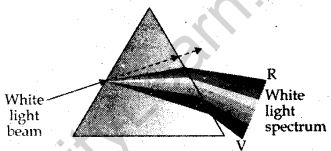
Answer.
- The splitting up of white light into seven colours on passing through a transparent medium like a glass prism is called dispersion of light.
- We get different colours of light when , white light is passed through a glass prism because white light is a mixture of lights of seven colours: red, orange, yellow, green, blue, indigo and violet. The dispersion of light occurs because the angle of refraction (or angle of bending) of
lights of different colours is different when passing through the glass prism.
Question.14 (a) What is meant by the power of accommodation of an eye?
(b) A person with a myopic eye cannot see objects beyond 1.2 m directly. What should be the type of the corrective lens used? What would be its power?
Answer.
(a) The ability of an eye to focus the distant objects as well as the nearby objects on the retina by changing the focal length or converging power of its lens is called accommodation.
A normal eye has a power of accommodation which enables objects as far as infinity and as close as 25 cm to be focussed on the retina.
(b) Myopic eye
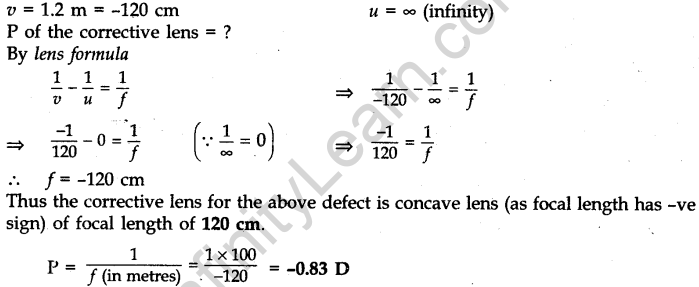
Question.16 Give an example of body characteristics used to determine how close two species are in terms of evolution and explain it.
Answer. The presence of feathers in dinosaurs and birds indicates that they are evolutionarily related. Dinosaurs had feathers not for flying but instead these feathers provided insulation to these warm-blooded animals. However, the feathers in birds are used for flight. This proves that reptiles and birds are closely related and that the evolution of wings started in reptiles.
Question.18 Write chemical equations to show what happens when
(i) ethanol is heated with concentrated sulphuric acid at 443 K.
(ti) ethanol reacts with ethanoic acid in the presence of an acid acting as a catalyst,
(iii) an ester reacts with a base.
Answer.
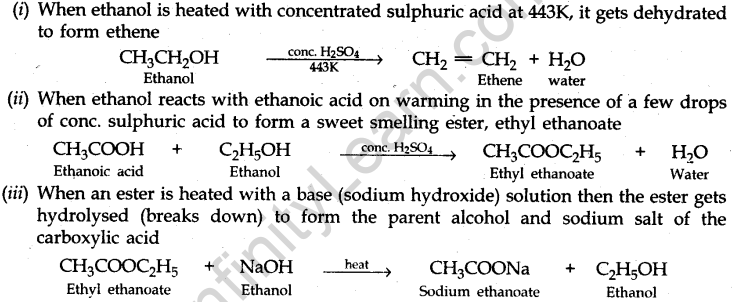
SET III
Except for the following questions, all the remaining questions have been asked in Set-I and
Set-II.
SECTION A
Question.1 Name two decomposers operating in our environment.
Answer. Bacteria and fungi are the two decomposers operating in our environment.
Question.2 What is meant by a biodegradable waste?
Answer. Those waste materials which can be broken down to non-poisonous substances in nature in due course of time by the action of micro-organisms like certain bacteria and fungi are called biodegradable waste. For example, peels of fruits and vegetables, cattle dung etc.
Question.3 Draw the structure of the hexanal molecule,C5H11CHO.
Answer. Hexanal molecule, C5H11CHO:

Question.4 Name the type of particles which act as prisms in the formation of rainbow in the sky. Answer.The rain drops in the atmosphere act like many small prisms. As white sunlight enters and leaves these raindrops, the white light splits into an arch of seven colours of rainbow.
Question.5 How does an embryo get nourishment inside the mother’s body?
Answer. After implantation, a disc-like special tissue develops between the uterus wall and the embryo called placenta. The exchange of nutrients, oxygen and waste products between the embryo and the mother takes place through the placenta.
Question.7(a) How does the size of atoms of elements vary down a group in the periodic table?
Why is it so?
(b) What does the tendency to lose electrons vary down a group in the periodic table? Give reason. IV2
Answer. (a) On going down in a group of the periodic table, the size of atoms increases because on going down in a group, a new shell of electrons is added to the atoms at every step due to which the size of atoms also increases.
(b) Tendency to lose electrons goes on increasing down the group because one energy shell is added at every step on going down in a group therefore the distance between the valence electrons and the nucleus and the force of attraction between the nucleus and the valence electrons decreases, therefore, tendency to lose electrons increases down the group.
Question.10 What is a spectrum? Why do different coloured rays deviate differently on passing through a glass prism?
Answer. Meaning of spectrum. When a beam of white light is passed through a prism, a band of
seven colours is formed on a white screen. This is called spectrum of white light.
The dispersion of white light occurs because the angle of refraction or angle of bending of different components of the white light is different when passing through the glass prism. When white light consisting of seven colours falls on a prism, each colour is refracted or deviated by a different angle, with the result that the seven coloured band, i.e., spectrum is formed.
Question.15 What are homologous organs? Can the wings of a butterfly and the wings of a bat be regarded as homologous? Why?
Answer. Those organs which have the same basic structure but different functions are called homologous organs.
The wings of a butterfly and the wings of a bat cannot be regarded as homologous because they have different basic design though they are used for the same purpose of flying.
Question.16 Describe two examples of different oxidations of ethanol. Name the products obtained in each case.
Answer.
- Ethanol bums readily in air with a blue flame to form carbon dioxide and water vapour and releasing a lot of heat and light.

- When ethanol is heated with alkaline potassium permanganate solution or acidified potassium dichromate solution, it gets oxidised to ethanoic acid. It is also called controlled combustion.

Question.20(a) What are the values of (i) near point and (ii) far point of vision of a normal adult
person?
(b) A student has difficulty in reading the blackboard while sitting in the last row. What could be his defect of vision? Draw a ray diagram to illustrate this defect of vision.
Answer. (a)
- The nearest point up to which the eye can see an object clearly without any strain is called the near point of the eye. The near point of a normal human eye is at a distance of 25 cm from the eye.
- The farthest point from the eye at which an object can be seen clearly is known as the far point of the eye. The far point of a normal human eye is at infinity.
(b) This defect of vision is called myopia. See Q. 17, 2011 (I Outside Delhi).
[Page P-18-19






